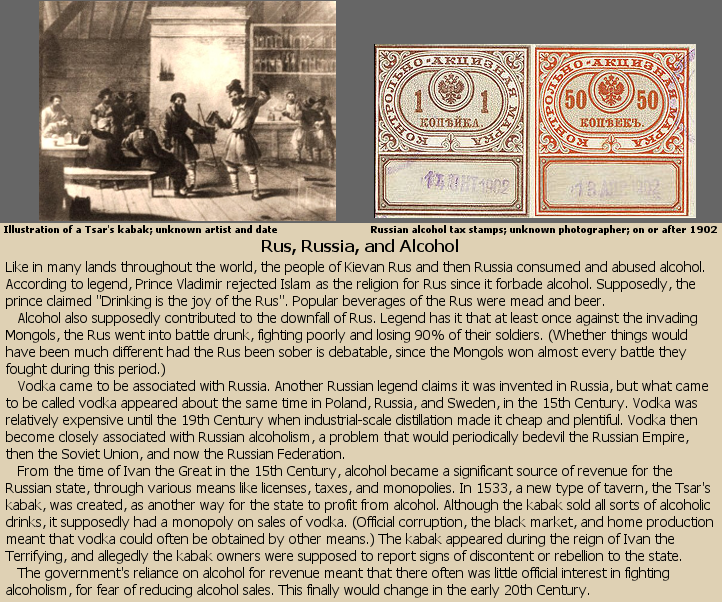

Rus, Russia, and Alcohol
Like in many lands throughout the world, the people of Kievan Rus and then Russia consumed and abused alcohol. According to legend, Prince Vladimir rejected Islam as the religion for Rus since it forbade alcohol. Supposedly, the prince claimed "Drinking is the joy of the Rus". Popular beverages of the Rus were mead and beer.
Alcohol also supposedly contributed to the downfall of Rus. Legend has it that at least once against the invading Mongols, the Rus went into battle drunk, fighting poorly and losing 90% of their soldiers. (Whether things would have been much different had the Rus been sober is debatable, since the Mongols won almost every battle they fought during this period.)
Vodka came to be associated with Russia. Another Russian legend claims it was invented in Russia, but what came to be called vodka appeared about the same time in Poland, Russia, and Sweden, in the 15th Century. Vodka was relatively expensive until the 19th Century when industrial-scale distillation made it cheap and plentiful. Vodka then become closely associated with Russian alcoholism, a problem that would periodically bedevil the Russian Empire, then the Soviet Union, and now the Russian Federation.
From the time of Ivan the Great in the 15th Century, alcohol became a significant source of revenue for the Russian state, through various means like licenses, taxes, and monopolies. In 1533, a new type of tavern, the Tsar's kabak, was created, as another way for the state to profit from alcohol. Although the kabak sold all sorts of alcoholic drinks, it supposedly had a monopoly on sales of vodka. (Official corruption, the black market, and home production meant that vodka could often be obtained by other means.) The kabak appeared during the reign of Ivan the Terrifying, and allegedly the kabak owners were supposed to report signs of discontent or rebellion to the state.
The government's reliance on alcohol for revenue meant that there often was little official interest in fighting alcoholism, for fear of reducing alcohol sales. This finally would change in the early 20th Century.
Comments
Drinking alcohol to excess has been an image and even stereotype of Russians for centuries. It was a surprise, then, that when reliable statistics started to become available in the 19th Century, Russian per-capita alcohol consumption was lower than French consumption. Even if this was correct (Russia contained several religious groups that limited use of alcohol, so per-capita consumption among the actual drinkers must have been higher), Russian customs towards alcohol encouraged abuse. In France and some southern European countries, daily consumption of some alcohol with meals was usual. In contrast, many Russians reserved alcohol for special occasions, when many would engage in binge drinking, resulting in drunkenness.
It can be said that the Russian government abused alcohol in its own way. Alcohol taxes and fees came to make up 30% to 40% of the central government's revenues, a vast sum the government did not want to jeopardize, even as alcohol abuse and alcoholism among Russians became undeniable problems. Further, the Tsar's kabaks, whose revenues went to the government, would sell alcohol on credit, plunging some, perhaps many, Russian drinkers into debt that they struggled to escape. At times, it is claimed that up to one-third of Russian men were in debt to their kabak. To those opposed to alcohol abuse, Tsar's kabaks had become dens of drunkenness and larceny, encouraging petty crime and domestic abuse.
Tsar's kabaks were established in cities, towns, and even villages across Russia. Many became the centers of village life. Since most Russians were illiterate, government proclamations were often read to the people at the kabaks. Not everything went the government's way, of course. In 1648, government taxes raised the price of salt and vodka, and drunken Russian riflemen began rioting at kabaks in Moskva. Together with other causes, this turned into an uprising of many city people against nobles and merchants, in which perhaps 20,000 houses were burned and 2,000 people died before order was restored.
Alcohol could even be a problem at the political pinnacle of the country. Ivan the Terrifying often drunk to excess and is claimed to have deliberately kept his court inebriated at times, to quash dissent of his often-brutal decisions. When Ivan's wife died, Ivan's drinking increased greatly, further unleashing his brutality. Ivan and his drunken court would revel as prisoners were tortured around them. Centuries later, Stalin would often force his inner circle of government and party advisors to drink to excess in late-night gatherings. These became worse after Stalin's wife died. Unlike Ivan the Terrifying, however, Stalin was not a drunkard. Although he did drink, it seems it was rarely to excess and was often much less than what he forced others to drink. Also, on a least one occasion, it was discovered that Stalin was drinking wine while pretending to drink stronger spirits like those around him. His drunken cronies were expected to put a full day's work after drinking most of the night with Stalin. At times during Stalin's rule, the USSR was run by high government officials who were sleep deprived, exhausted, and hung-over. Some of them became alcoholics. However, spare little sympathy for them, as they were the ones who willing implemented Stalin's will, which resulted in millions of innocent people being arrested, tortured, imprisoned in forced-labor camps, or executed.